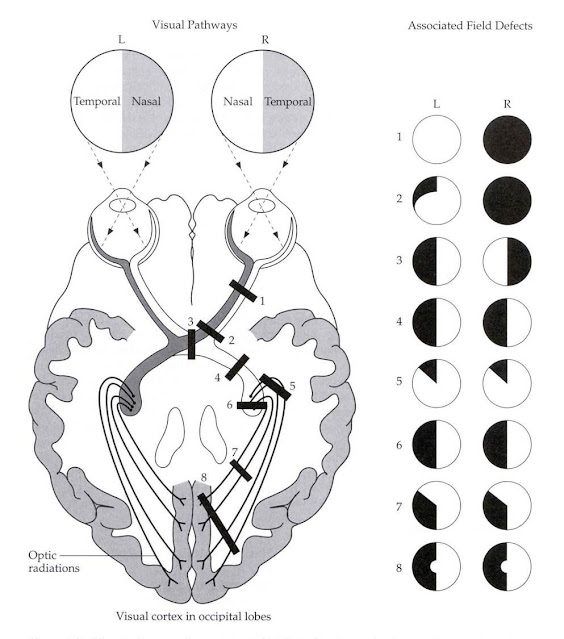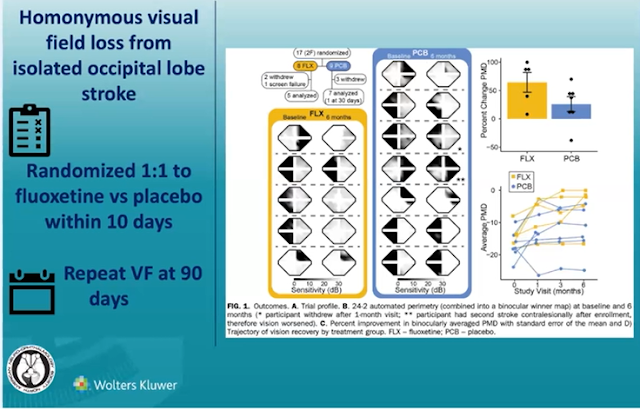Could a Medication Reverse Vision Loss After Stroke?
10:47Vision loss is one of the most common side effects of a stroke, occurring in 65% of stroke survivors according to the American Stroke Association. And for 20% of those people, the visual field loss is permanent. But could a medication help recover lost visual field? New studies show the this may be possible.
Stroke and Vision Loss
A stroke occurs when blood flow is blocked or greatly reduced to the brain, resulting in reduced oxygen and nutrient flow to the delicate brain tissue. It takes only a matter of minutes of disrupted blood flow to cause devastating damage to brain tissue. The majority of strokes (around 90%) are a result of blocked blood vessel flow (called ischemic stroke) and the rest are from internal bleeding (called hemorrhagic stroke). A stroke is a medical emergency, so if you experience any of these symptoms call 911 immediately:
 |
| image via Duke Health |
When a stroke affects the vision areas of the brain (typically the occipital or parietal lobes), permanent vision loss can result. A 2013 study of 915 patients who had suffered a stroke revealed that 52% of them had visual field loss, causing difficulty reading, double vision, blurry vision, and visual perception difficulties. Traditional treatments for patients who experienced stroke-related vision loss are focused on helping patients adapt to their changed visual world. Specialists in vision therapy or low vision can help patients with visual search and visual awareness training, prism glasses, occlusive patches, or even low vision aids. In this UK based study, of the patients who saw a vision specialist following their stroke only 7.5% had full recovery, 39% had improvement, and 52% had no recovery. Two patients (1%) had further decline of visual field.
 |
| Associated visual field loss (in black) related to part of the brain where injury or stroke caused damage. via |
Could A Medication Improve Visual Field Loss?
New studies have raised awareness that there may be more doctors can do to increase the chance of visual field recovery than therapy programs alone. Two medications have shown possible improvement in visual fields if they are initiated soon after the stroke occurs.
Fluoxetine
In a June 2023 study published in the Journal of Neuro-Ophthalmology, 17 patients who had homonymous hemianopia (visual field loss in both eyes) following a stroke were enrolled in a double blind, placebo controlled study within 10 days of their stroke event. Half of study participants were given 90 days of 20 mg fluoxetine daily, and half were in the placebo group. The results showed statistically significant benefit of fluoxetine despite the low number of patients in this study; when visual field was rechecked in 6 months the original blind field completely recovered in 60% receiving fluoxetine and in only 14% receiving placebo.
 |
| Look at the fluoxetine group (in the yellow box) to see the visual field improvement from baseline to 6 months. Some patients had significant improvement, some had minimal or none. Despite very low study numbers, compared to placebo the patients taking fluoxetine did have statistically significant better rates of visual field recovery. Check out this Ophthalmology Times video podcast to hear MDs discuss the results! |
Fluoxetine (brand name: Prozac, Sarafem, Rapiflux, Selfemra) is a selective serotonin reuptake inhibitor (SSRI) that is typically prescribed for anxiety, depression, or obsessive compulsive disorders. Fluoxetine is commonly prescribed for patients with post-stroke depression, and the mechanism of why using this medication could potentially increase the chance for visual field loss improvement is not fully understood. The working hypothesis is that fluoxetine increases the brain's neuroplasticity, allowing it to more easily rewire around damaged tissue and form new connections that would help the person recover more of their lost visual field.
More research with larger study groups will be needed to confirm this effect, but if confirmed, these results have the potential to overhaul our current management of patients who suffer visual field loss after a stroke!
Minocycline
Several case reports have shown that starting minocycline soon after stroke can also increase the chance of visual field recovery. Minocycline is a tetracycline antibiotic, but it also has known anti-inflammatory properties with high penetration through the blood-brain barrier. In 2007 researchers studied 152 patients who had suffered acute ischemic stroke. Patients were given an initial dose of 200 mg of minocycline within a 6-24 hour window of their stroke, and then a daily 200 mg dose for the next 5 days. Patients were then evaluated on days 7, 30, and 90 using the modified Rankin Scale, Barthel Index, and National Institutes of Health (NIH) stroke scale which scores items like level of consciousness, visual field loss, facial paresis, language, and motor abilities. The minocycline-treated group showed significant improvement over the placebo at every assessment time and with all monitoring endpoints.
Since that time there have been several case reports of patients with visual field loss experiencing recovery after minocycline use soon after their initial stroke event. One patient even had benefit with minocycline dosed 3 weeks after his stroke. He reported vision and cognition subjectively seemed to improve within a few days of starting his minocycline 100 mg twice daily treatment for 5 days.
Larger clinical trials to assess the role minocycline may have in improving visual field loss after stroke are currently enrolling through the NIH.
Take Home
More research is needed, but these small studies and case reports show a possible benefit from well tolerated and inexpensive medication options. The key to any benefit appears to be in early treatment. If you or a loved one has suffered a stroke and have symptomatic vision loss, consideration of these treatments early into your stroke recovery process is worth consideration and a discussion with your doctor!
For optometrists that are often monitoring post-stroke patients with visual field testing, or providing vision therapy for stroke rehabilitation, consideration of discussing these treatment options with the patient's medical care team early after the initial stroke event may also be warranted.
Where historically we have been able to give little hope for true visual field recovery, there is a lot of potential excitement if these treatments or others prove to be efficacious and become the new standard of care for patients who have suffered a stroke.

.png)












.jpg)

0 komentárov